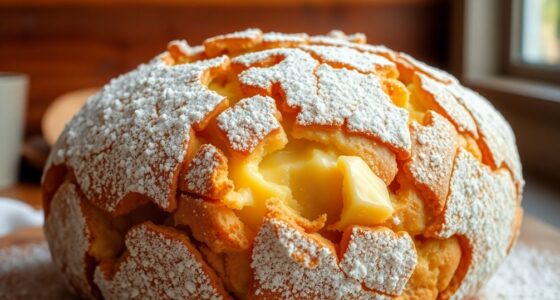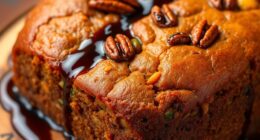Cinnamon rolls are a delightful treat you can't resist! Originating from Sweden and Germany, these soft, sweet rolls are made with a rich dough filled with cinnamon and sugar, then topped with creamy icing. They're ideal for breakfast or dessert and pair perfectly with coffee or tea. You can make them easily at home, and the aroma while baking is unbeatable. Want to discover some tips on preparation and serving suggestions? There's more to learn!
History
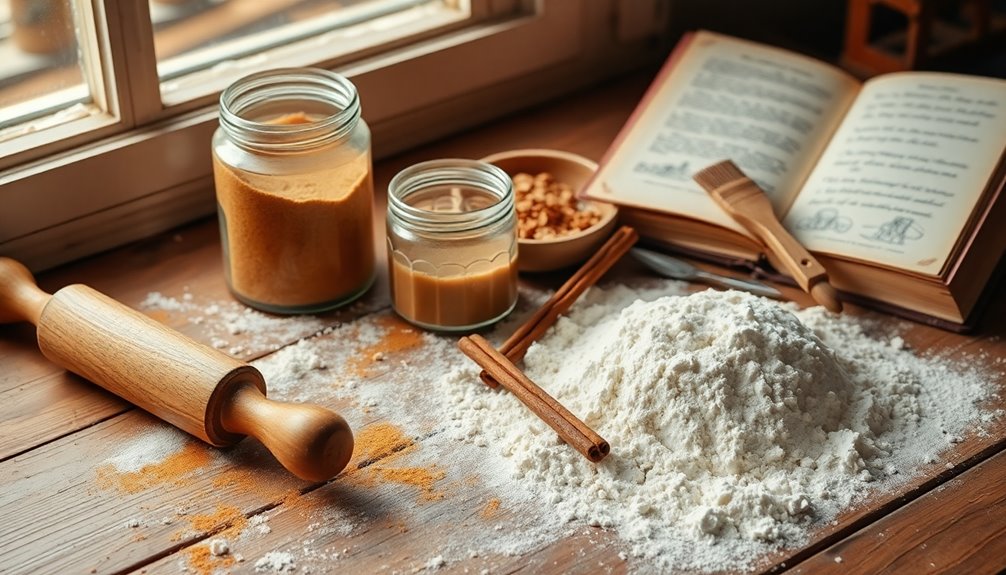
Cinnamon rolls have a fascinating history that stretches back to ancient times. Early versions appeared in Sweden and Germany, where they were known as "kanelbullar" and "Zimtschnecken."
The modern cinnamon roll you enjoy today originated in the United States, particularly thriving in the 19th century thanks to the Scandinavian immigrant community. A significant turning point was the introduction of cream cheese frosting in the 1980s, which elevated the flavor and richness of these rolls.
The Cinnabon brand, founded in 1985, helped popularize cinnamon rolls in fast food, leading to a surge in their consumption. Now, you can find cinnamon rolls as a breakfast treat or dessert, with numerous regional variations and gourmet adaptations showcasing local tastes and ingredients.
Recipe

Homemade cinnamon rolls are a delightful treat that can brighten any morning or special occasion. With their soft, fluffy texture and sweet, gooey filling, they're sure to please anyone who takes a bite. The process of making cinnamon rolls is straightforward, but it does require some patience, especially during the rising time, which is crucial for achieving that perfect fluffy consistency. The aroma of cinnamon and sugar wafting through your kitchen as they bake is a bonus that makes the effort worthwhile.
Homemade cinnamon rolls bring joy to any occasion with their fluffy texture and irresistible sweet filling.
To start your cinnamon roll journey, you'll need to gather your ingredients and set aside some time for preparation. The dough is enriched with butter and eggs, giving it a rich flavor and tender bite. The filling, made from brown sugar and cinnamon, adds a warm sweetness that's irresistible. Whether you choose to top your rolls with cream cheese frosting or a simple powdered sugar glaze, these cinnamon rolls will become a favorite in your home.
Ingredients:
- 4 cups all-purpose flour
- 1/2 cup granulated sugar
- 2 1/4 teaspoons instant yeast
- 1/2 cup unsalted butter, softened
- 1 cup milk, warmed
- 2 large eggs
- 1/2 cup brown sugar, packed
- 2 tablespoons ground cinnamon
- 1/4 cup butter, softened (for filling)
- Optional: cream cheese frosting or powdered sugar glaze for topping
Instructions:
In a large mixing bowl, combine the flour, granulated sugar, and instant yeast. In a separate bowl, mix the warmed milk and softened butter until melted, then add the eggs and whisk until combined.
Pour the wet ingredients into the flour mixture and knead until a soft dough forms. Cover the bowl and let the dough rise in a warm environment for 60-90 minutes or until it has doubled in size.
Once risen, roll out the dough into a rectangle, spread the softened butter for the filling, and sprinkle the brown sugar and cinnamon evenly over it. Roll the dough tightly and cut it into individual rolls. Place the rolls in a greased baking dish and allow them to rise again for about 30 minutes.
Preheat the oven to 375°F (190°C) and bake the rolls for 24-27 minutes until golden brown and cooked through.
Extra Tips:
For the best results, ensure your ingredients are at room temperature before starting, particularly the butter and eggs, to help the dough rise effectively.
If you find your dough is sticky, add a little more flour, but be careful not to overdo it, as too much flour can lead to dense rolls.
When baking, check for doneness by using a thermometer to ensure they reach an internal temperature of 195-200°F (91-93°C).
Lastly, applying the icing while the rolls are still warm will allow it to melt slightly and soak in, enhancing the flavor and texture of your finished rolls. Enjoy!
Cooking Steps
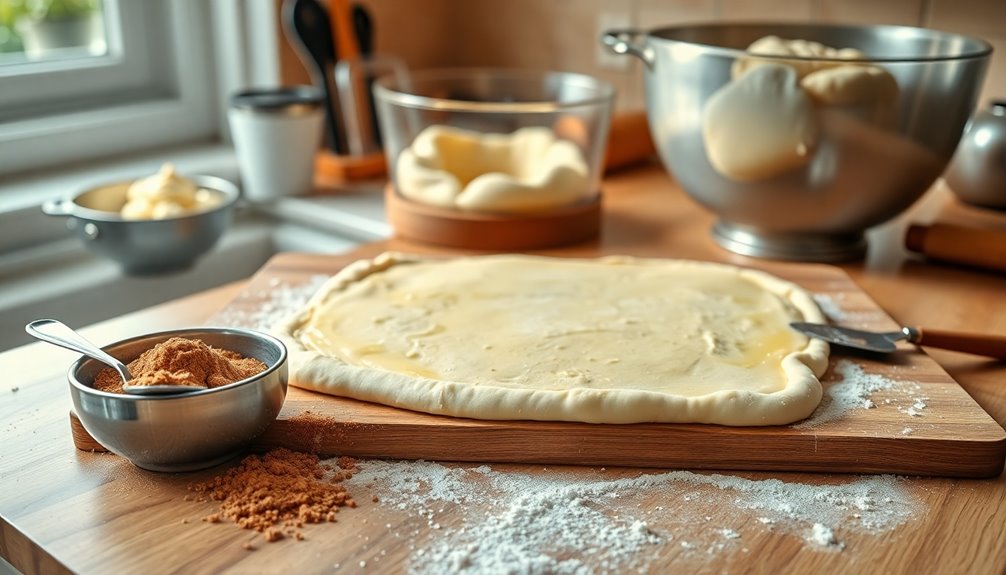
To make delicious cinnamon rolls, you'll start by preparing the dough mixture, ensuring everything blends smoothly.
Once the dough is ready, let it rise until it doubles in size before rolling and cutting it into perfect shapes.
Finally, bake those rolls until they turn golden brown and irresistible!
Step 1. Prepare the Dough Mixture
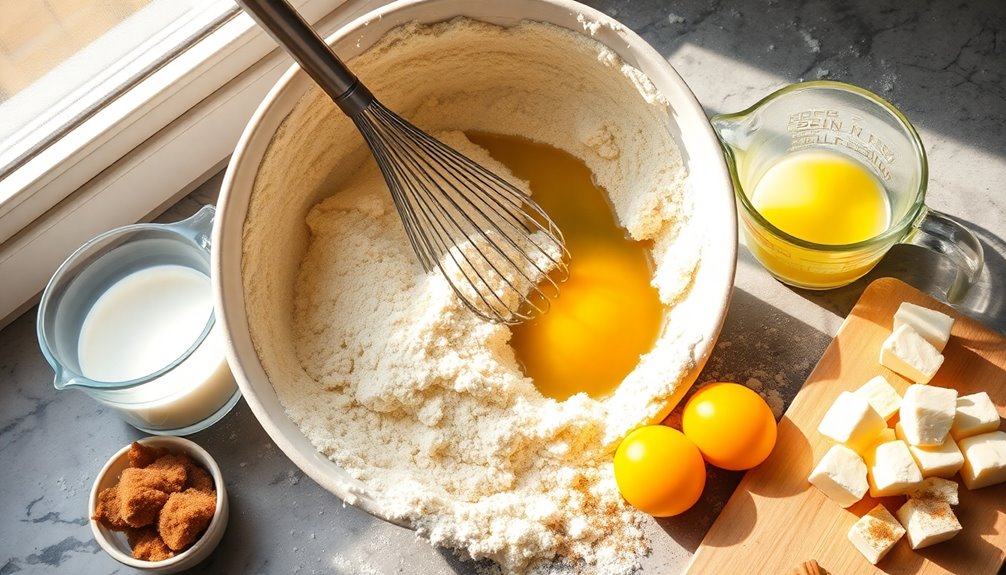
Start by whisking together the dry ingredients in a large bowl, ensuring the flour, sugar, yeast, and salt are evenly distributed.
Next, heat the milk and melted butter until it's warm—about 100-115°F (38-46°C)—to activate the yeast without killing it. You can add a bit of sugar to help kickstart this process.
Combine the warm liquid mixture with the dry ingredients, stirring until a shaggy dough forms; be careful not to add too much flour, as you want to maintain a soft texture.
Knead the dough on a floured surface for a few minutes to promote gluten development.
Finally, let the dough rise in a warm, draft-free spot until it's puffy and has doubled in size, roughly 60-90 minutes.
Step 2. Knead Until Smooth and Elastic
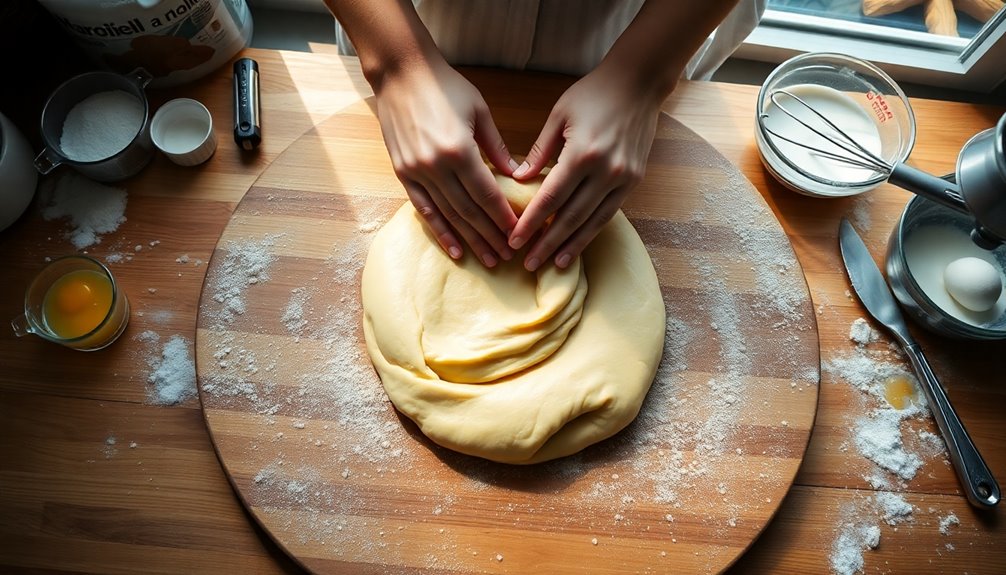
After letting the dough rise, it's time to knead it until smooth and elastic. On a floured surface or using a stand mixer with a dough hook, knead the dough for 3-5 minutes.
You want it to become smooth and elastic, signaling that the gluten has developed properly. The dough should feel tacky but not overly sticky, holding its shape without needing too much extra flour.
To check gluten development, perform the "windowpane test" by stretching a small piece; it should form a thin membrane without tearing. If the dough feels dense, let it rest for 15 minutes before kneading again.
Keeping the environment warm (around 70°F) boosts yeast activity, improving the rise and texture of your cinnamon rolls.
Step 3. Let Dough Rise Until Doubled
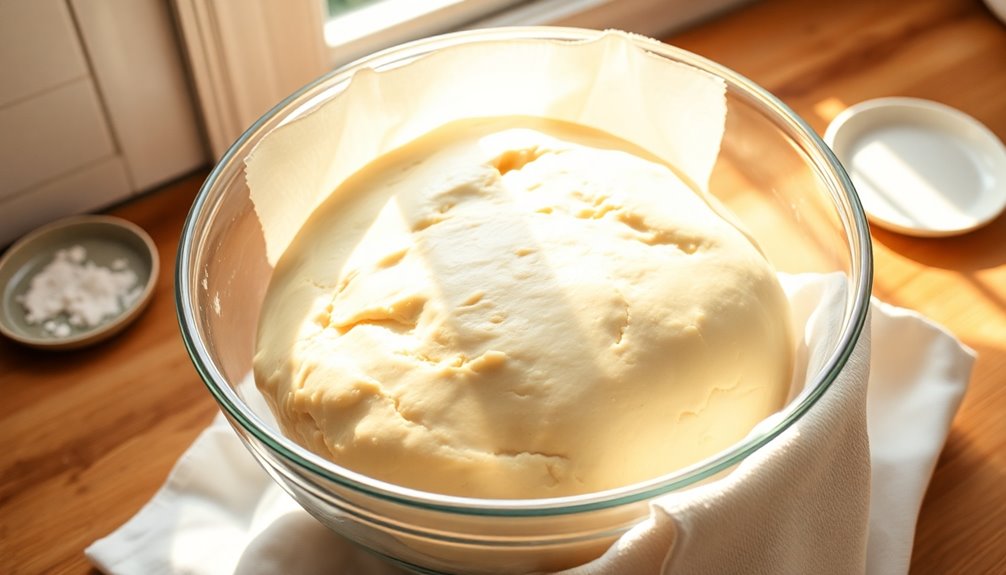
Once you've kneaded the dough to a smooth and elastic consistency, it's time to let it rise.
Place the dough in a larger bowl to give it space to expand. Cover it loosely with a clean kitchen towel or plastic wrap to retain moisture and prevent a crust from forming.
Find a warm, draft-free environment where the temperature is around 75-80°F (24-27°C). This is crucial; if it's too cold, the yeast may become inactive, and the dough won't rise effectively.
Allow the dough to rise until it doubles in size, which usually takes about 60-90 minutes. To check readiness, gently poke it with your finger; if the indentation remains, it's time to move on.
Step 4. Roll and Cut the Dough
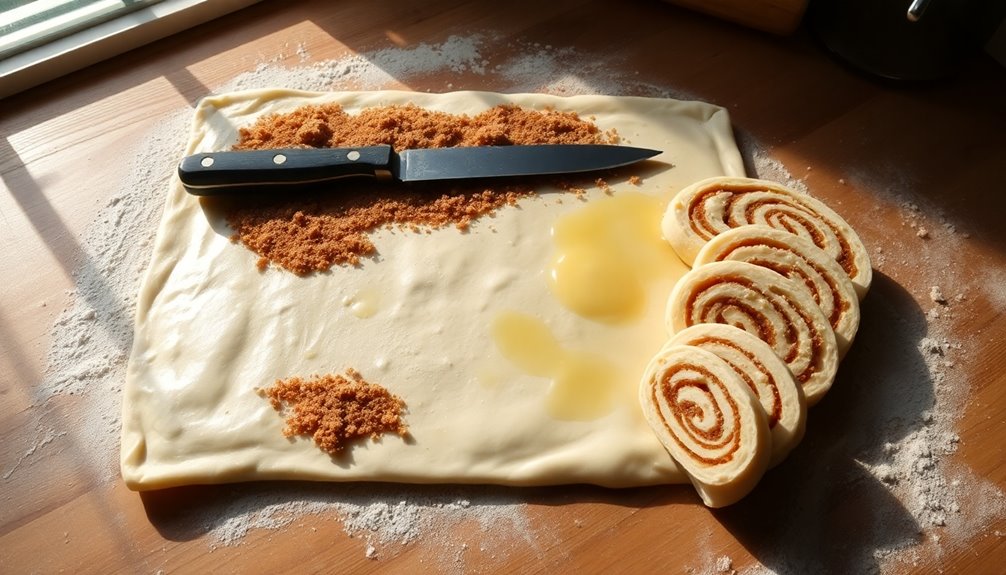
Turn the risen dough onto a lightly floured surface and roll it out into a rectangle, measuring about 14 by 10 inches.
Spread softened butter evenly over the rolled-out dough, creating a rich base for your filling. Next, evenly sprinkle a mixture of brown sugar and cinnamon over the buttered surface, enhancing the flavor.
Starting from one long edge, tightly roll the dough into a log, ensuring a snug fit to keep the filling intact.
Once rolled, use a sharp knife or unflavored dental floss to cut the dough into equal slices, about 1 to 1.5 inches thick. This method ensures uniform baking and a beautiful presentation for your cinnamon rolls.
Step 5. Bake Until Golden Brown
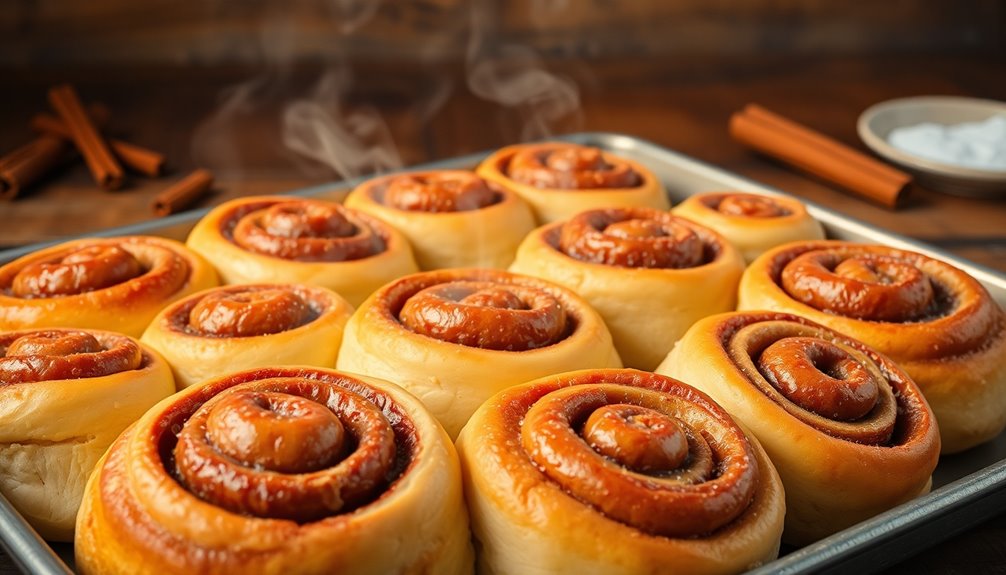
Preheat your oven to 375°F (190°C) to kick off the baking process for your cinnamon rolls.
Place the rolls in the oven and bake until golden brown, which should take about 24-27 minutes. Keep an eye on them; you're looking for a lightly golden brown color and a nice rise.
To ensure optimal doneness, check the internal temperature; it should be between 195°F and 200°F (91°C to 93°C). If the tops brown too quickly, cover them loosely with aluminum foil during the last few minutes.
Once out of the oven, allow the cinnamon rolls to cool slightly in the pan. This step makes them warm and gooey, perfect for soaking in that delicious frosting!
Final Thoughts

As you savor the warm, gooey goodness of homemade cinnamon rolls, it's easy to see why they've become a cherished favorite.
The soft dough, enriched with a yeast mixture and fragrant vanilla extract, creates a fluffy texture that practically melts in your mouth. As you roll out your dough with a rolling pin, the enticing aroma of cinnamon sugar fills the air, promising deliciousness.
Don't forget the cream cheese icing that adds a rich finish to each bite. With the option for overnight refrigeration, you can prepare these treats in advance for special occasions.
Whether you add nuts or experiment with flavors, every batch of cinnamon rolls is a delightful experience worth sharing with loved ones.
Enjoy the magic of baking!
Frequently Asked Questions
Why Put Heavy Cream on Cinnamon Rolls Before Baking?
When you add heavy cream before baking, you're enhancing the dish's overall texture and flavor.
The cream soaks into the dough, making it rich and gooey while caramelizing as it bakes. This technique keeps your baked goods moist, ensuring they don't dry out.
Plus, it introduces a buttery richness that elevates the dish, transforming the bottom into a delicious, caramel-like sauce that adds a delightful indulgence to every bite.
What Is the Cinnabon Secret Ingredient?
If you're curious about the secret ingredient that makes Cinnabon's treats stand out, it's a unique blend of cinnamon called Makara cinnamon.
Sourced from Indonesia, this special cinnamon adds a distinct flavor and aroma that you won't find anywhere else.
Coupled with rich cream cheese frosting and a buttery, fluffy dough, it's this blend that elevates the entire experience, making each bite unforgettable.
You'll definitely taste the difference!
What's the Difference Between Cinnamon Buns and Cinnamon Rolls?
If you think all baked goods are the same, you're in for a delicious surprise!
The difference between cinnamon buns and cinnamon rolls lies in their dough and texture. Cinnamon buns usually feature a firmer, denser dough, while cinnamon rolls are soft and fluffy.
Buns often come topped with a thicker icing, while rolls get that gooey cream cheese glaze.
These subtle distinctions make each treat uniquely mouthwatering, so dive in and enjoy!
What Is a Dirty Cinnamon Roll?
A "dirty cinnamon roll" is an indulgent twist on a classic treat, often featuring unconventional ingredients or toppings.
You might find fillings like chocolate, caramel, or unique spices that elevate the flavor. The term "dirty" suggests a messy presentation, with icing or glaze generously dripping down the sides.
It also hints at a rustic appearance, sometimes using darker sugars or cocoa powder. These visually extravagant creations have become popular on social media, attracting dessert lovers everywhere.





